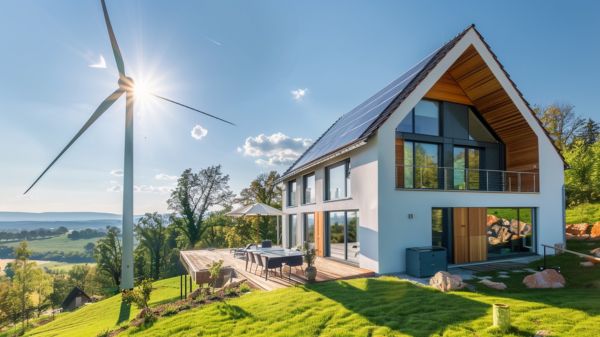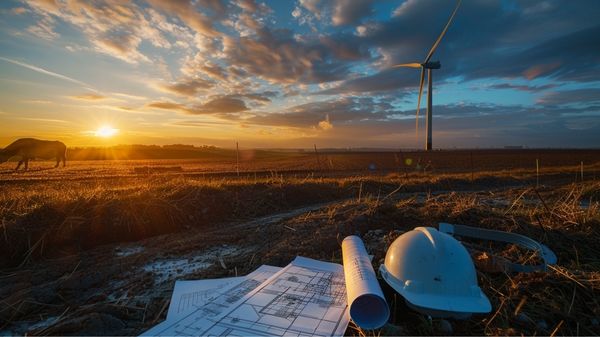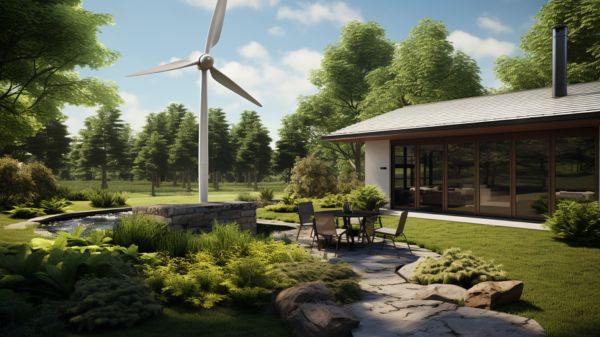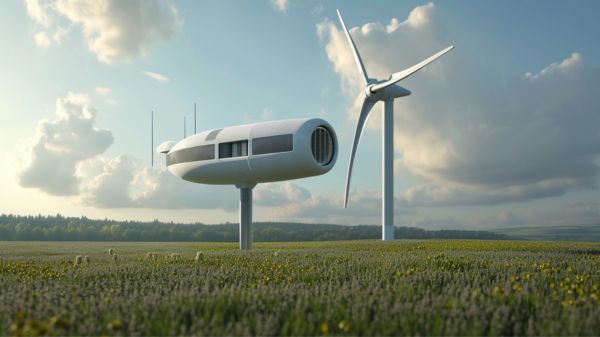Wind turbines stand as a demonstration of human ingenuity in harnessing natural forces, achieving efficiencies that surpass traditional energy sources. How wind turbines generate electricity efficiently? The secret to their success lies in the blend of cutting-edge aerodynamics and materials science.
Blades designed to capture wind energy with minimal loss are essential, but there is more to their efficiency. Advances in technology allow these turbines to adapt in real-time to changing wind conditions, maximizing output.
While these factors contribute considerably to their performance, one might wonder what other underlying technologies or methodologies further enhance their efficiency. This leads to an exploration of lesser-known aspects that bolster their effectiveness in energy generation.
Harnessing Kinetic Energy
How do wind turbines efficiently convert the kinetic energy of wind into electrical power?
Wind turbines are essential in harnessing kinetic energy, translating the motion of wind into mechanical power which is then converted to electricity through a generator. This process is enhanced through careful consideration of turbine hub height and rotor diameter, critical factors that greatly influence energy conversion efficiency.
The height of the turbine hub is important; as it increases, turbines access higher wind speeds available at elevated altitudes. In 2022, the average hub height reached approximately 98 meters, allowing turbines to capture more kinetic energy. This elevation not only harnesses stronger winds but also contributes to a steadier wind flow, crucial for consistent power generation.
Energy conversion efficiency of wind turbines, typically ranging from 40% to 50%, is a reflection of the effectiveness of these structures in generating wind power. Despite the theoretical maximum (Betz Limit) being about 59%, ongoing technological advancements continue to push these boundaries, working for greater efficiency.
Aerodynamic Blade Design
The design of wind turbine blades is a significant factor in maximizing the aerodynamic efficiency required for enhancing energy capture from wind. These blades are meticulously crafted into aerodynamic shapes that are fundamental in reducing drag and enhancing lift. This streamlined form is essential not only for effective energy capture but also for the conversion efficiency of the kinetic energy into usable electrical power.
Over recent years, the evolution in blade designs has seen a significant increase in the rotor diameters of turbines—expanding from 115 meters in 2010 to over 130 meters by 2022. This increase translates into a larger swept area, capturing more wind and thereby augmenting the potential for wind energy generation.
The strategic adjustment of the blade’s angle of attack is another refinement enhancing this capability, allowing turbines to maintain ideal performance across varying wind conditions.
These innovations in blade design are critical in achieving an average conversion efficiency of about 50%, marking a substantial advancement in the technology’s ability to harness wind power.
Advanced Material Usage
Utilizing advanced materials such as carbon fiber and fiberglass, wind turbine blades are engineered to be both lightweight and robust, greatly enhancing their efficiency in harnessing wind energy. These materials elevate the blades’ capacity for energy capture while maintaining structural integrity against environmental stresses.
Innovations in turbine blade technology have led to increases in rotor diameters, now averaging over 130 meters, which allows turbines to sweep larger areas and generate more power. This scale-up is essential in wind energy technologies where efficiency translates directly to increased electricity production and reduced carbon footprint.
The integration of flexible materials has revolutionized blade design, offering superior aerodynamic performance and adaptability in diverse wind conditions. This flexibility not only maximizes efficiency but also extends the lifespan of turbine components, greatly reducing the need for frequent replacements and lowering maintenance costs.
Furthermore, advancements in the manufacturing processes of these advanced materials have made it more cost-effective to produce larger, more efficient blades.
Such strategic use of advanced materials in wind turbines supports the global shift towards sustainable energy sources, ensuring that these technologies remain both economically viable and environmentally responsible. This approach not only liberates communities from reliance on non-renewable energy but also empowers them through enhanced access to clean, efficient wind power.
Control Systems Optimization
Advanced control systems in wind turbines dramatically enhance energy efficiency by refining blade pitch based on variable wind speeds.
These systems, vital in modern turbines, adjust the angle of blades in real-time, leveraging data-driven insights to maximize energy capture and maintain ideal rotor performance. This dynamic adjustment not only boosts efficiency but also mitigates mechanical wear, extending the lifespan of turbine components.
Incorporating real-time monitoring, these control systems continuously analyze operational data, allowing for the swift adaptation to changing wind conditions.
This capability is critical for refining turbine performance and maximizing output, ensuring that each gust of wind translates into a maximum generation of renewable energy. By integrating predictive analytics, such as weather forecasting and wind speed predictions, turbines can operate closer to their design limits safely and efficiently.
Furthermore, the latest advancements in control algorithms enhance the capability of turbines to perform in turbulent conditions, which traditionally pose challenges to energy extraction.
This innovation leads to a significant reduction in downtime and an increase in overall turbine efficiency by 5-10%. Consequently, refined control systems are essential in harnessing the full potential of wind energy, symbolizing a step towards sustainable power liberation.
Grid Integration Techniques
As we explore grid integration techniques for enhancing wind turbine efficiency, it is vital to focus on implementing smart management systems.
These systems leverage real-time data to optimize energy flow and increase the adaptability of the grid to fluctuating wind outputs.
Additionally, renewable balancing strategies are essential for synergizing wind energy with other renewable sources, ensuring a stable and efficient power supply while minimizing environmental impact.
Smart Management Systems
Smart management systems are essential in enhancing the integration of wind energy into the grid by leveraging sophisticated forecasting models to optimize energy production and distribution.
These systems are at the forefront of grid integration, using advanced algorithms to predict wind patterns accurately, thereby allowing for more strategic energy dispatch. This not only maximizes the output from wind turbines but also synchronizes this generation with grid demand, ensuring that energy is not only produced efficiently but also utilized effectively.
Furthermore, smart management systems permit real-time monitoring and control over wind turbines. This capability is vital for maintaining operational efficiency and adjusting outputs based on instant data analysis. By integrating such technologies, these systems enable a finer balance between supply and wind energy availability, contributing greatly to grid stability and reliability.
Additionally, the integration techniques employed include demand response programs which adjust consumption patterns in response to wind energy generation. This dynamic adaptation not only bolsters energy efficiency but also fortifies the grid against fluctuations and potential disturbances.
The utilization of energy storage solutions further complements these efforts, capturing excess energy during peak wind periods and releasing it during lows, thereby smoothing out the supply curve and ensuring a consistent energy flow.
Renewable Balancing Strategies
Renewable balancing strategies, including demand response mechanisms and energy storage systems, are essential for effectively integrating wind power into the electrical grid, guaranteeing adaptability during variable wind conditions.
Advanced forecasting technologies play a vital role in this integration by enhancing the predictability of wind patterns, thereby guaranteeing a reliable renewable energy source. This accuracy supports operators in maintaining grid stability by anticipating the energy output and making requisite adjustments swiftly.
Strategic use of energy storage also buffers the variability of wind, storing excess energy during high production and releasing it during low. This smooths out the fluctuations in wind energy availability, facilitating a steady flow of power.
Smart grid technologies contribute further by enabling real-time monitoring and automated adjustments in power distribution, significant for integrating wind power seamlessly with other energy sources.
Here’s an overview of key strategies and technologies:
| Strategy/Technology | Role in Wind Power Integration |
|---|---|
| Demand Response | Adjusts consumer energy use to balance supply-demand mismatches |
| Energy Storage Systems | Provides backup during low wind periods |
| Forecasting Technologies | Predicts wind patterns to optimize generation |
| Flexible Gas Plants | Complements wind by adjusting output as needed |
| Smart Grids | Monitors and manages energy flows in real-time |
These collaborative efforts guarantee the effective integration of wind as a sustainable and stable energy solution.
Environmental Impact Reduction
Shifting to the topic of environmental impact reduction, it is vital to highlight the significant role of wind turbines in mitigating CO2 emissions.
By preventing approximately 336 million metric tons of carbon dioxide annually, wind technology exemplifies a pivotal advancement in sustainable energy systems.
In addition, strategic turbine placement and operational protocols are essential in preserving biodiversity, ensuring minimal disruption to local wildlife and habitats.
CO2 Emissions Avoidance
Wind turbines considerably reduce environmental impact by avoiding approximately 336 million metric tons of CO2 emissions annually in the U.S. This significant reduction is equivalent to the emissions produced by 73 million cars, showcasing wind energy as a formidable force against climate change.
As a renewable resource, wind power stands at the forefront of sustainable energy solutions, actively displacing the need for electricity generated from fossil fuels. This shift not only curtails direct carbon emissions but also mitigates the broader spectrum of greenhouse gas emissions associated with conventional energy production.
The technical efficiency of wind turbines, as indicated by an energy return on investment (EROI) ranging from 18:1 to 20:1, underscores their capability to convert natural wind resources into usable electricity with minimal environmental cost.
By 2050, if wind energy were to account for 35% of U.S. electricity, it could reduce greenhouse gas emissions by 23%. This change to wind energy not only supports the reduction of our carbon footprint but also enhances air quality and public health, reinforcing the role of wind power in fostering a resilient, sustainable energy future.
Embracing wind energy liberates communities from the environmental and health burdens posed by conventional energy sources.
Biodiversity Preservation Efforts
Efforts to integrate wind turbines into natural environments increasingly focus on preserving biodiversity and reducing ecological disruptions. As a cornerstone of sustainable energy deployment, turbine siting is scientifically strategized to minimize habitat disturbance and wildlife interactions. Advanced studies and environmental impact assessments inform these placements, ensuring that turbines harmonize with, rather than disrupt, local ecosystems.
The development of floating offshore wind plants exemplifies proactive measures to mitigate environmental impacts. By elevating structures above the seabed, these innovations preserve the underlying marine habitats, demonstrating a commitment to biodiversity conservation while expanding renewable energy capacities. This approach considerably reduces interference with marine life, aligning with principles of ecological preservation.
Moreover, the implementation of certifications and adherence to strict guidelines underscore the industry’s dedication to sustainable practices. These standards not only promote ecosystem health but also safeguard avian populations, as evidenced by relatively low avian mortality rates from turbines compared to other anthropogenic threats.
Scalability and Versatility
The scalable nature of wind energy technology allows for its application in diverse settings, from vast utility-scale projects to compact, individual installations. This scalability is essential in harnessing wind resources effectively across different geographical landscapes.
Utility-scale wind turbines, with increasing rotor diameters and taller hub heights, now access more consistent and stronger winds aloft. For instance, average hub heights have reached about 98 meters (322 feet) on land, with projections of up to 150 meters (500 feet) for offshore installations by 2035. This ability to capture higher altitude winds enhances efficiency, making wind energy a more viable option across various regions.
Moreover, the modular design of wind turbines supports scalable deployment. Components can be standardized and then scaled up or down, depending on the energy needs and site specifications. This modularity not only simplifies manufacturing and maintenance but also tailors installations to specific environments, whether it’s a large wind farm or a small community setup.
The evolution towards turbines with higher nameplate capacities, averaging 3.2 MW in 2022, further underscores the trend towards fewer, more powerful units, optimizing both space and resources while expanding wind energy’s role in sustainable power generation.
Conclusion
To sum up, wind turbines exemplify efficiency in renewable energy technology through their integration of advanced aerodynamics, lightweight materials, and dynamic control systems.
These features not only optimize energy capture and conversion but also contribute to significant reductions in environmental impact.
The scalability and versatility of modern wind turbines further enhance their utility across diverse geographic locales, demonstrating a sustainable pathway for future energy infrastructures that prioritize ecological integrity and economic viability.




